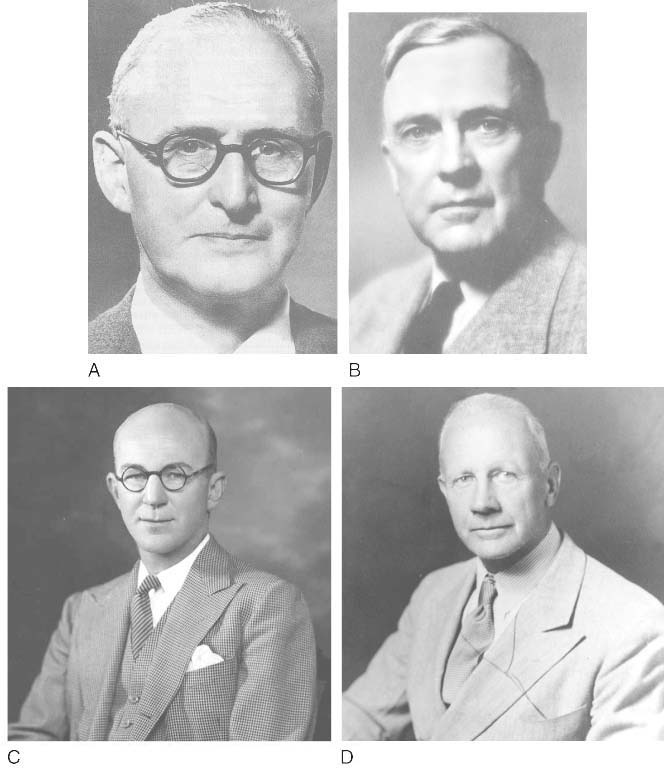 |
 |
Figure 1-18
Prominent anesthesiologists of the 20th century. A,
Sir Ivan Whiteside Magill (1888–1986) was born in Larne, Northern Ireland.
He obtained a medical degree from Queen's University, Belfast, in 1913. During
World War I, he served with the Irish Guards in the Medical Corps. After the war,
he and Stanley Rowbotham (1890–1979) pioneered the use of large-bore endotracheal
tubes to allow plastic surgeons to operate on the facial injuries of wounded soldiers.
He designed many pieces of equipment for the anesthesiologist, some of which are
still used today. Before his death at the age of 98 years, he received many awards,
including a knighthood awarded personally by the Queen of England in 1960 and the
Henry Hill Hickman Award. B, Ralph M. Waters was
born in North Bloomfield, Ohio, and obtained his medical degree from Western Reserve
University in Cleveland. He began his career in general practice in Sioux City,
Iowa, and specialized in delivering anesthesia in 1916. Waters established the first
academic program of anesthesiology in Madison, Wisconsin, in 1927. His contributions
were many and included the carbon dioxide absorption method, endobronchial anesthesia
for thoracic surgery, and introduction of cyclopropane. His chief legacy is the
many residents he trained who then became the leaders within the specialty in the
following generation. C, Sir Robert R. Macintosh
(1897–1989) was born in New Zealand and was a prisoner of war during World
War I. He finished medical training after the war in London and began the practice
of anesthesia there. In 1937, he was appointed the first Nuffield Professor of Anaesthetics
at Oxford University. He was primarily a clinician, and his innovative techniques
of airway management were eventually accepted worldwide. He received honorary degrees
from universities in several countries and was knighted in 1955. D,
James T. Gwathmey was born in Roanoke, Virginia, in 1865 and graduated from the Vanderbilt
School of Medicine in 1899. In 1903, he limited his practice to the administration
of anesthetics, and he is considered one of the first full-time private practice
physician anesthesiologists in the United States. He devised several new innovations
for the delivery of anesthetic gases and introduced these machines to his European
colleagues during World War I. He was an original member of the Long Island Society
of Anesthetists, which eventually evolved into the American Society of Anesthesiologists.
(Courtesy of the Wood-Library Museum of Anesthesiology, Park Ridge, IL.)

 |
